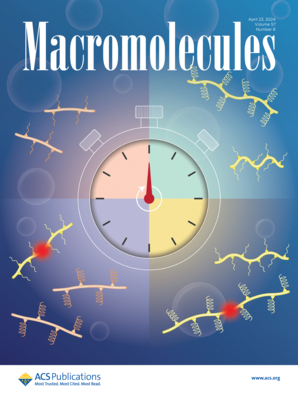Permselective Transport of Cu2+ through Polymer Networks Functionalized with Iminodiacetic Acid
IF 5.1
1区 化学
Q1 POLYMER SCIENCE
引用次数: 0
Abstract
Cost-effective technologies for recovering or recycling materials from waste streams are needed to support the growing demand for critical elements and materials. In this work, we investigate ligand-functionalized membranes with ion-specific selectivity toward Cu2+ over Ni2+ and Mg2+. We prepared a series of membranes functionalized with the iminodiacetic acid (IDA) functional group, which binds preferentially to Cu2+ over Ni2+ and Mg2+. The membranes varied in terms of IDA content and water content, and the salt sorption, diffusion, and permeation were quantified over a range of solution pH values, which impact the binding energy of the IDA group to divalent cations. We observed that IDA-functionalized membranes had strong sorption selectivity toward CuCl2 at a pH near 1, and the sorption selectivity increased with increasing IDA content. On the other hand, the membranes exhibited diffusivity-selectivity toward NiCl2 and MgCl2 over CuCl2. However, at a pH near 1, where sorption selectivity was highest, the membranes were permselective toward CuCl2 over NiCl2 and MgCl2. Furthermore, the permselectivity was influenced by the membrane water content, and permselectivity increased with decreasing water content. This reflects a permselectivity–permeability trade-off for ion-specific membranes, which has not been previously reported. This work provides insight into the design of membranes with ion-specific permeabilities and identifies important factors that impact sorption, diffusion, and permeability selectivity, including the ion-specific ligand content, water content, and solution pH. This work also demonstrates ligand-functionalized membranes permselective toward Cu2+ over Ni2+ and Mg2+, with permselectivity as high as 2.8:1. This work can lead to ion-selective separation processes for the recovery of Cu2+ and design strategies for the recovery of ions of interest.

为了满足对关键元素和材料日益增长的需求,我们需要具有成本效益的技术来从废物流中回收或循环利用材料。在这项工作中,我们研究了配体官能化膜对 Cu2+ 和 Mg2+ 的离子特异选择性。我们制备了一系列具有亚氨基二乙酸(IDA)官能团的膜,该官能团能优先结合 Cu2+ 而不是 Ni2+ 和 Mg2+。膜的 IDA 含量和含水量各不相同,在一定的溶液 pH 值范围内对盐的吸附、扩散和渗透进行了量化,pH 值会影响 IDA 基团与二价阳离子的结合能。我们观察到,在 pH 值接近 1 时,IDA 功能化膜对 CuCl2 具有很强的吸附选择性,而且吸附选择性随着 IDA 含量的增加而增加。另一方面,相对于 CuCl2,膜对 NiCl2 和 MgCl2 具有扩散选择性。然而,在吸附选择性最高的 pH 值接近 1 时,膜对 CuCl2 的吸附选择性高于对 NiCl2 和 MgCl2 的吸附选择性。此外,过选择性受膜含水量的影响,含水量越低,过选择性越高。这反映了离子特异性膜的过选择性与渗透性之间的权衡,而这在以前还没有报道过。这项工作为设计具有离子特异性渗透性的膜提供了启示,并确定了影响吸附、扩散和渗透选择性的重要因素,包括离子特异性配体含量、水含量和溶液 pH 值。这项工作还证明了配体功能化膜对 Cu2+ 的渗透选择性高于 Ni2+ 和 Mg2+,渗透选择性高达 2.8:1。这项工作可以开发出回收 Cu2+ 的离子选择性分离过程,并设计出回收相关离子的策略。
本文章由计算机程序翻译,如有差异,请以英文原文为准。
求助全文
约1分钟内获得全文
求助全文
来源期刊

Macromolecules
工程技术-高分子科学
CiteScore
9.30
自引率
16.40%
发文量
942
审稿时长
2 months
期刊介绍:
Macromolecules publishes original, fundamental, and impactful research on all aspects of polymer science. Topics of interest include synthesis (e.g., controlled polymerizations, polymerization catalysis, post polymerization modification, new monomer structures and polymer architectures, and polymerization mechanisms/kinetics analysis); phase behavior, thermodynamics, dynamic, and ordering/disordering phenomena (e.g., self-assembly, gelation, crystallization, solution/melt/solid-state characteristics); structure and properties (e.g., mechanical and rheological properties, surface/interfacial characteristics, electronic and transport properties); new state of the art characterization (e.g., spectroscopy, scattering, microscopy, rheology), simulation (e.g., Monte Carlo, molecular dynamics, multi-scale/coarse-grained modeling), and theoretical methods. Renewable/sustainable polymers, polymer networks, responsive polymers, electro-, magneto- and opto-active macromolecules, inorganic polymers, charge-transporting polymers (ion-containing, semiconducting, and conducting), nanostructured polymers, and polymer composites are also of interest. Typical papers published in Macromolecules showcase important and innovative concepts, experimental methods/observations, and theoretical/computational approaches that demonstrate a fundamental advance in the understanding of polymers.
 求助内容:
求助内容: 应助结果提醒方式:
应助结果提醒方式:


